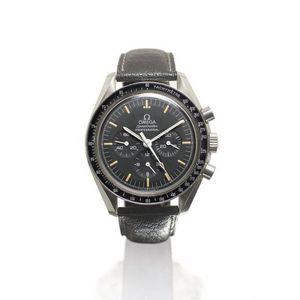Chronoswiss Retrograde Calendar Chronograph Wristwatch
You must be a subscriber, and be logged in to view price and dealer details.
Subscribe Now to view actual auction price for this item
When you subscribe, you have the option of setting the currency in which to display prices to $Au, $US, $NZ or Stg.
- Moon Dial - If we imagine life in the 17th century, the only source of ascertaining the time of day or night would have been the local church or municipal clock striking every quarter hour, and able to be heard by all in the village. In England, when longcase clocks became popular and more affordable in the late 17th century, the function of timekeeping and source of time was moved to within the home.
An additional feature on some longcase clocks was to display the phases of the moon, that is the new moon, the full moon and the waning moon over the lunar 29 ½ day cycle. This information was important for farmers for working out cropping schedules; for travellers to know the amount of moonlight on a night they planned to travel; and for those who lived near the sea required knowledge of the tides.
Where included, the moon dial is usually in the form of a disc incorporated into the main dial plate, usually in the arched top section. The lunar cycle starts with the new moon displaying, which is a dark night sky and no man-in-the-moon face being displayed, and then progresses to the full moon face showing on the 15th day of the lunar cycle, and back to no face displaying as the moon wanes. Most lunar dials are partially concealed on each side of their opening in the main dial plate by semi-circular "humps" that allow the painted face to emerge slowly just as the real moon goes out of and back into the earth's shadow.
Nowadays, details of the lunar cycle is published in diaries, almanacs, and newspapers and although some modern longcase clocks are still manufactured with working moon dials, they are more for decoration than for use. - Movement - The technical name for the workings of a clock or watch, and does not include the dial or case.
- Circa - A Latin term meaning 'about', often used in the antique trade to give an approximate date for the piece, usually considered to be five years on either side of the circa year. Thus, circa 1900 means the piece was made about 1900, probably between 1895 and 1905. The expression is sometimes abbreviated to c.1900.
- Subsidiary Dial - On a clock or watch, a subsidiary dial, also called an auxiliary dial, is a dial that is secondary to the main dial and may show seconds, day of the week or month, or strike silent. A subsidiary dial may be within our outside the main dial, and a clock or watch may have several subsidiary dials.
- Date Aperture - A date aperture is a cut out section in the face of a watch or clock, displaying the day of the month.
- Chronograph - A chronograph is a watch that also incorporates the features of a stopwatch, to measure elapsed time. Most chronographs are operated by two buttons, one to start and stop the chronograph second hand, and the other to return that hand to the starting position.
- Guilloche - A form of classical decoration consisting of a repeating ornament of interlacing curved bands, sometimes forming circles, and further decorated with rosettes or other flower forms.
The name is derived from the inventor, French engineer Guillot, who invented a mechanical method of inscribing fine repeating patterns on to metallic surfaces.
On enamelled items with guilloche decoration, the surface is firstly engraved with the repeating pattern, and then covered with several layers of enamel, each of which is fired.
Where the item has not been enamelled the form of decoration is usually called "engine turned".
This item has been included into following indexes:
Visually similar items

Porsche design, aluminium, titanium and Rubber P'6000 chronograph wristwatch, Ref. 6610.14, quartz movement, grey dial with luminous baton markers and luminous hands, three subsidiary dials, tachymeter scale, aperture for date, dial, case and movement sign

Panerai, a stainless steel automatic cushion-form wristwatch with date ref Op 6524 BB1005893 C1278/1500 Luminor Gmt PAM063 circa 2001, automatic winding movement, fully jewelled, mono-metallic balance, matt black dial, applied luminescent Arabic and baton

Maurice Lacroix Gent's chronograph wrist watch, Ref, Mp 6318, Masterpiece Croneo no. AN52179 with black dial, split centre seconds, 3 subsidiary dials, day and date on a automatic movement, transparent screw back in stainless steel to leather band with dep

Omega A stainless steel chronograph wristwatch with registers mvt 48338639 case 1450022 3450022 Speedmaster circa 1990, cal. 861 manual winding movement, fully jewelled, black dial, luminescent baton indexes, three subsidiary dials for constant seconds, 30
